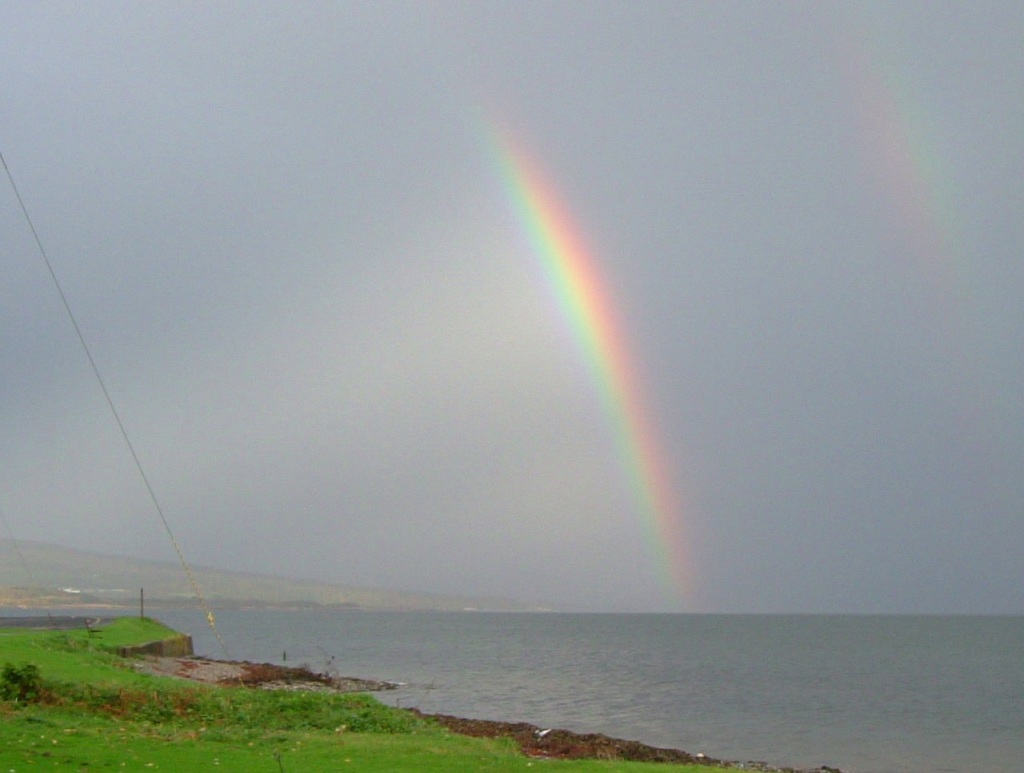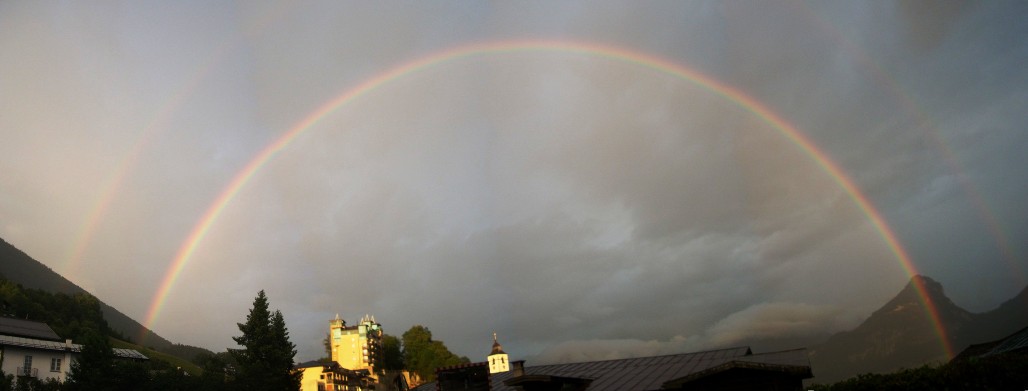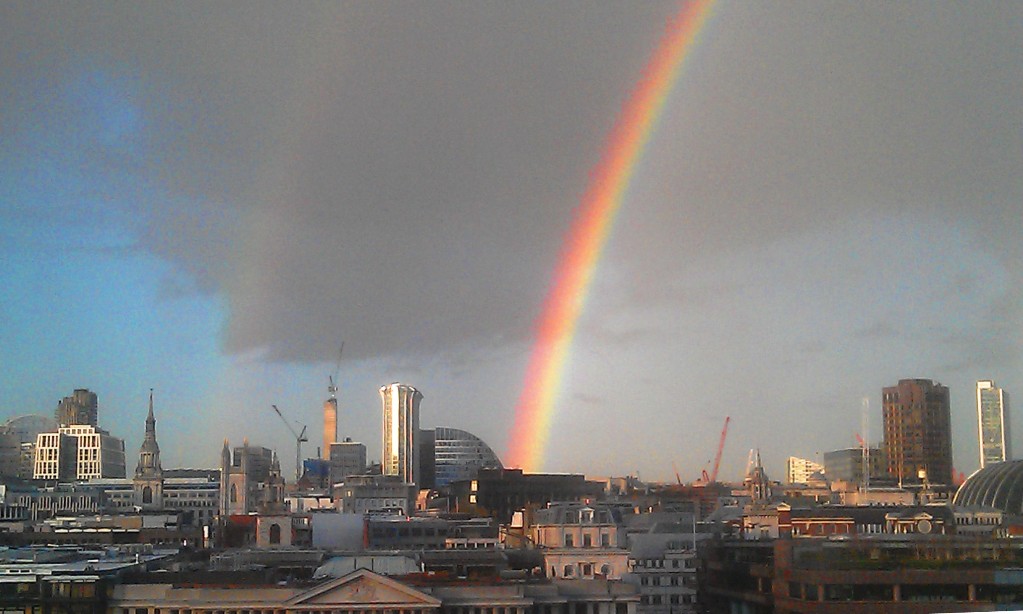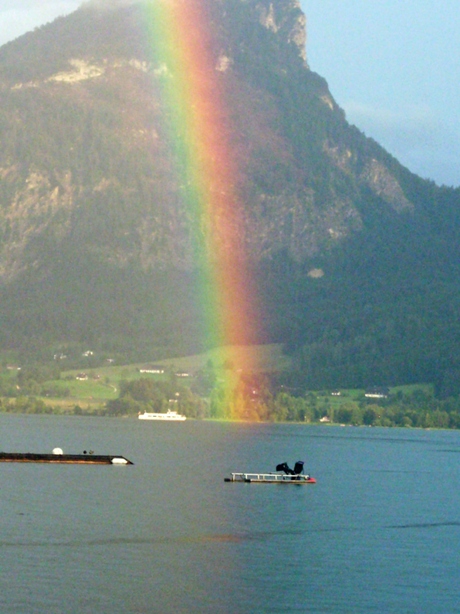It is an unusual person who, on seeing a rainbow, does not take a moment or two to stop and admire it. I know I always look up at one and following our March talk from David Whitehouse entitled “Rainbows and Astronomy”, I am now more aware of what I am actually seeing.
David Whitehouse was BBC Science correspondent for nearly 20 years and is now an author. He recently became intrigued with rainbows, the Physics of them and their place in our culture, and the talk was based on his latest book which is about them. He gave a tantalising introduction to some ideas about how rainbows are formed and here is my take on some of those. This has turned into a rather long article – my apologies about that ! I can see now why David found rainbows so fascinating.
The different colours of a rainbow are produced by different raindrops.
First some revision of school science. A rainbow is created when sunlight hits raindrops. The light is refracted as it enters the drop, is internally reflected at the back of the drop and refracts again as it leaves. Different colours are refracted by different amounts and hence so-called white light is dispersed into a spectrum. Given the reflection within the raindrop, the blue light exits above the red light (unlike in a simple school prism experiment, where the red light is “on top”). What was new to me, though it is obvious once you think about it, was the idea that different raindrops are responsible for producing the different colours that reach your eye. Each raindrop produces a spectrum but depending on the position of the sun in the sky and the height of the raindrop, only one colour from any one raindrop will travel in the right direction to enter your eye. The red light is produced by raindrops which are relatively high in the sky; the blue light from these goes, literally, over your head. For the blue light to enter your eye, the relevant raindrop must be a bit lower in which case it is the red light which misses your eye. I did begin to attempt a diagram of this, then decided it was better to include a link for you: science.howstuffworks.com.

Image credit Katherine Rusbridge
You cannot see a rainbow when the sun is high in the sky.
Two important angles are 42o and 40o , the angles through which red and blue light respectively are deviated. If the sun is higher than 42o above the horizon, then you won’t see a rainbow no matter how much sunlight and how many raindrops there are because all the light is refracted in a direction to pass above you. As the sun slips down in the sky, then the possible position of a rainbow rises until at sunset, it should be 42o above the horizon. This explains why sometimes you see a rather shallow rainbow whereas if you catch sight of a rainbow at the beginning or end of the day, it will seem more like a full semi-circle.

A rainbow is affected by the size of the raindrops.
If the raindrops are very small, then the rainbow is rather wishy-washy (my description, not David’s!) The rainbow will be much brighter if the raindrops are bigger than about 0.3mm. I found quite a good explanation of this at this link: www.atoptics.co.uk. Rather than think of the different refraction effects of a single ray of white light hitting the raindrop at one point, think instead of the effect on , say, the red component of several rays entering the raindrop. Each one undergoes the same refraction process but the red rays exiting the raindrop will be slightly out of phase because the length of their path through the raindrop depends on exactly where along its curved surface they entered it . This difference in phase leads to interference effects, so although the spectrum has been produced, the coloured effect is then lost.
The sections near the horizon are often brighter, giving rise perhaps to the myth that there is gold at the end of a rainbow. This effect is caused by larger raindrops losing their spherical shape as they fall down, due to drag. This in turn changes the exact nature of the refraction effects from those low raindrops giving the observed result. I can’t attempt an explanation of this (for the obvious reason that I don’t understand it) but I’ll look out for it all the same the next time I see a rainbow.

Now for the astronomy bit.
Prisms had been used since the time of Newton to produce and study spectra. By the mid-1850’s, Robert Bunsen and Gustav Kirchoff had developed a simple spectroscope and identified the fact that every element when heated emits a distinctive colour which is actually made up of a set of well-defined wavelengths of light, known as a line spectrum. This acts as a bar-code for that element. This knowledge has played a pivotal role in many of the breakthroughs in astronomy.
David introduced us to a character in astronomy who deserves to be better known – William Huggins. He was the stereotypical amateur astronomer of Victorian times, building his own observatory which included a spectroscope. He used this to look at various features of the night sky and is credited with being the first to realise that a nebula is a gas cloud. He did this by comparing the line spectrum from the Orion Nebula with that from a galaxy. They were clearly very different with the Orion Nebula spectrum dominated by the barcode for hydrogen in contrast to the more complex set of line spectra from a typical galaxy.
David described the work of William Huggins as the beginning of astrophysics. Astronomers were no longer limited to describing just the positions of features but could begin to understand more about the workings of the Universe. The study of spectra most famously played its part in Edwin Hubble’s work. It was by looking at the line spectra from many galaxies and analysing the amount of red shift he saw in them that Hubble developed his ideas of the expanding Universe which led to the theory of the Big Bang.
And all this, beginning with a study of rainbows a few hundred years earlier !

Image Credit Peter Campbell-Burns
Talk given by astronomy journalist David Whitehouse
Post written by Katherine Rusbridge
March 2014
